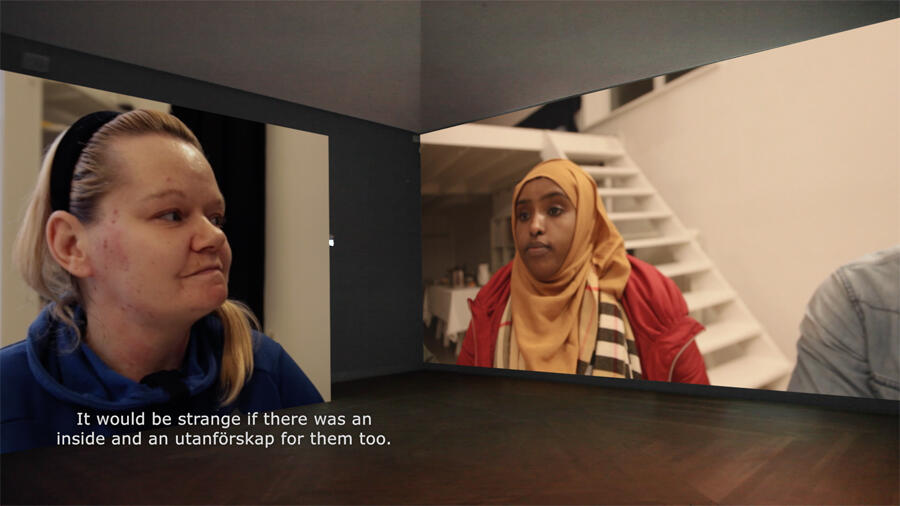The State is Not a Work of Art
At Tallinn Art Hall, an international group show grapples with the problematics underlying the concept of national identity
At Tallinn Art Hall, an international group show grapples with the problematics underlying the concept of national identity

I am Latvian. I am Latvian and the woman beside me is Chinese. An invigilator is from Bangladesh. I was originally British; the woman, Polish. I can’t say where the invigilator is from. Our newfound nationalities are detailed on lanyards distributed as part of Femke Herregraven’s Liquid Citizenship (2018), the physical aspect of which resembles a phone shop, stocked with discount bundles aplenty. For something close to GBP£210,000, you can take home Azerbaijani residence, or if you’re looking to the long-term, Philippine citizenship will require an investment of around £53,350. For a limited time, Herregraven is offering access to East Africa for just £7,115, but the fiends are in the fine print: you will enter via trafficking.
Herregraven’s project visualises the way in which capital has rendered national citizenship a commodity to be purchased, peddled and revoked. It’s apt for both its host country, Estonia, which recently introduced ‘e-citizenships’ in an attempt to bolster its economy, and its host exhibition, ‘The State is not a Work of Art’. Curated by Katerina Gregos, the show coincides with Estonia’s centenary and looks to the myriad problematics underlying the concepts of national identity, nationalism and the nation-state. Here, Gregos writes, we might replicate the dialectical problem-solving exercised in Hegel’s Philosophy of Right (1820), from which the show’s title derives: ‘“yes” versus “no” might result in the synthesis “maybe”.’

Some, like Herregraven, spear capital’s incessant corruptions. Larissa Sansour’s Gulf dystopic Nation Estate (2012), for one, reimagines Palestine as an ‘Amman Express’-branded skyscraper. Others whip nationalism’s already-putrid waters into a muddy blur. Gothenburg-born artist Loulou Cherinet’s film Statecraft (2017) documents roundtable discussions on the poisonously ambiguous terms innanförskap (insidership) and utanförskap (outsidership), which have plagued Sweden’s political battleground for the last decade. Most striking is the manner in which this terminology has been internalised. One attendee in a headscarf recalls describing racial abuse to a white friend, whose response (repulsion) ‘was annoying’. She continues: ‘I envy her innanförskap. I wish so much that I could […] live her reality, in her bubble.’
As theorist Miroslav Hroch outlines, nation-building requires a ceaseless reaffirmation of collective history: an overarching ‘we’ to repress the adversarial ‘they’. Stéphanie Lagarde’s film Déploiements (2018) forces the two to cohabit, splicing together footage of the French air force aerobatics team’s rehearsals for National French Day, with graphics lifted from crowd-control simulation software. As brutish jets harmoniously arc and swathes of protestors are contained, patriotism’s nefarious dualism is splayed wide: an artful control of power and an equivalent power of control.
Ewa Axelrad and Jaanus Samma unlatch reminiscence and revolt once more. For his performative work New Year’s Boy (2018), Samma reanimates the long-neglected Estonian tradition of the eponymous, who on New Year’s Eve would make house-calls in a conical straw costume. For Samma, like for Szabolcs KissPál and his From Fake Mountains to Faith (Hungarian Trilogy) (2016), a convoluted docu-fictional chronicle of Hungary, our nostalgic national narratives are patchworks – forgotten, unpicked or make-believe. Axelrad’s series ‘Shtamah’ (2017) draws on the Polish slang term sztama, which signals ‘accord, friendship’ and stems from the German root Stamm: ‘tribe’ or ‘stock’. The work is a riot: a turbulent soundtrack; a video of a punctured military vest; a fleshy materialisation of the garment; a line of wall-set wooden staffs, their curved trajectory quoting that of a swung flagpole or a truncheon striking a neck. Lacking allegiance to doctrine or domain, Axelrad’s choreographed frenzy is a frantic reminder that power will forever rest amongst the mobilized, whichever flag they elect to hoist.

On my final day in Tallinn, a friend and I were discussing Thomas Killper’s Burnout (2016), a set of charcoal drawings depicting arson attacks on German refugee camps, when a man joined us from the street. ‘What is this?’ he asked. Before we could explain, he interjected: ‘I could fill this building with pictures of attacks by immigrants. Are you communists?’ We responded in the negative, to no avail. ‘You are communists. This is propaganda. This is shit.’
‘The State is not a Work of Art’ does right by its intentions, but it also leaves me cold: I have seen this exhibition before, albeit in various guises. I have heard its arguments, bowed to its virtue and disregarded the new clothes that mask its liver spots. I have also observed its ultranationalist, conservative, anti-liberal-establishment targets prosper, unfazed by its interrogators’ creative manoeuvres. I will never demand an art that provides answers, but I will plead for one that sets the right questions to the right people, and as I stood in an empty gallery and failed to connect with Thomas Locher’s A Hundred Thousand Billion Societies (2017) – a stack of boxes emblazoned with aphorisms about belonging – throngs of locals ghosted past, perspectives unchanged. The state is not a work of art. But this exhibition, this project of ours, it is. Maybe that’s the problem. We operate within a gilded frame that partitions speculation and reality. If, unbeknownst to us, the surrounding walls have begun to yellow, then perhaps we should welcome that external invigilator, one who, unconverted, is happy to vocalise our greatest anxiety: ‘This is shit’.
The State is Not a Work of Art runs at Tallinn Art Hall until 29 April.
Main image: Stéphanie Lagarde, Déploiements, 2018, film still (detail), single channel digital video, colour, sound, 16’00”. Courtesy: the artist and Tallinn Art Hall; photograph: © Karel Koplimets
























